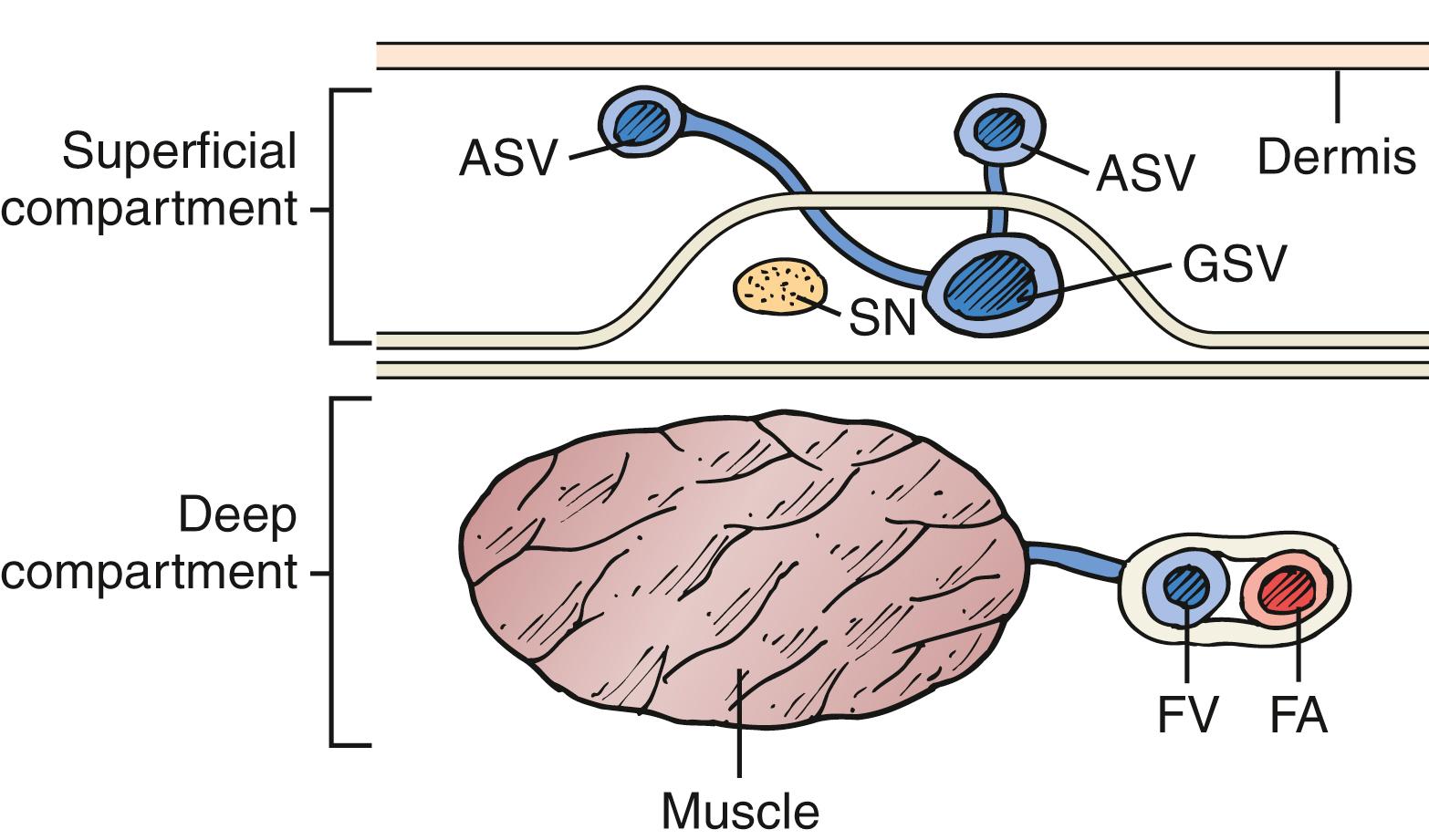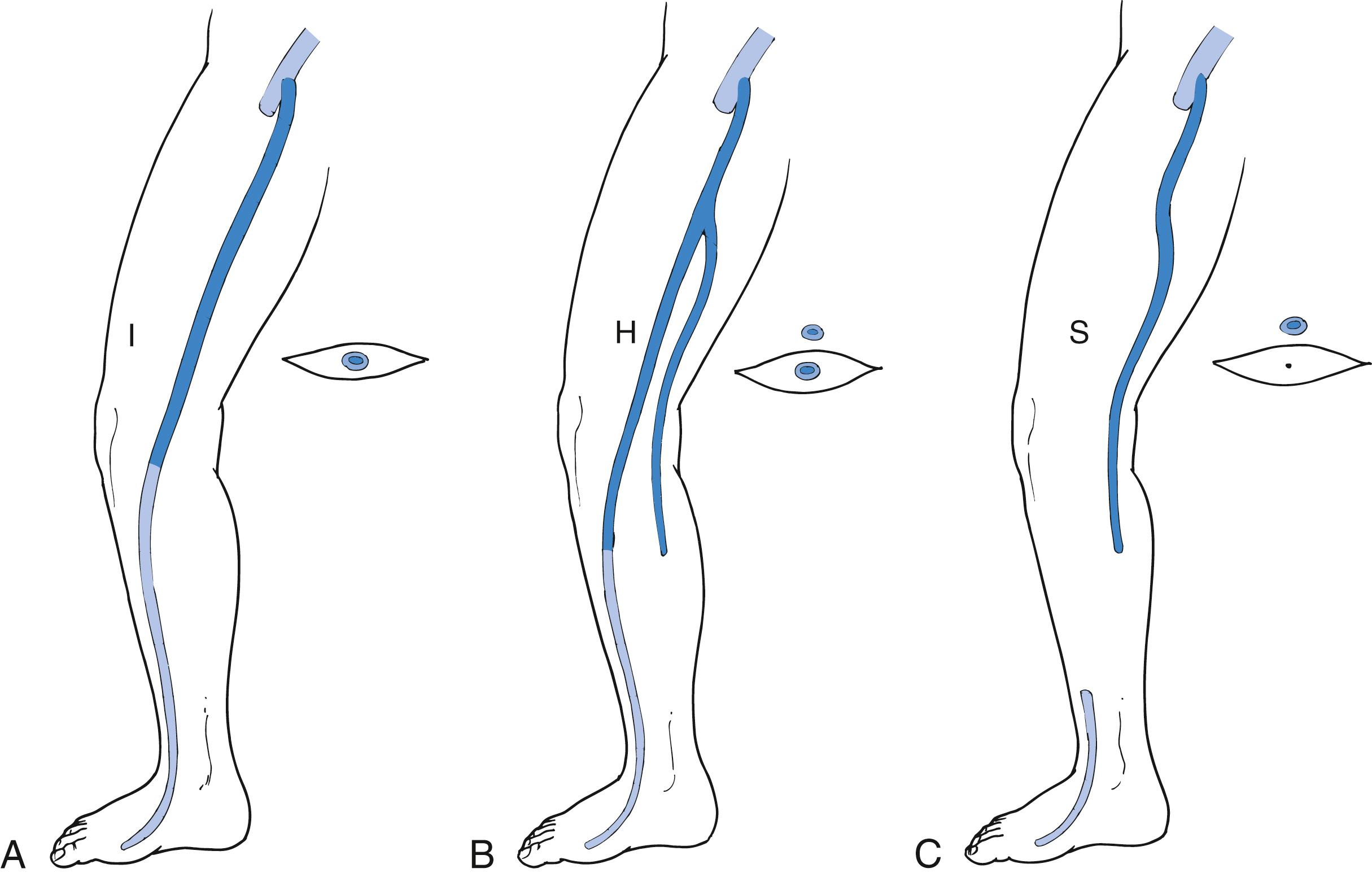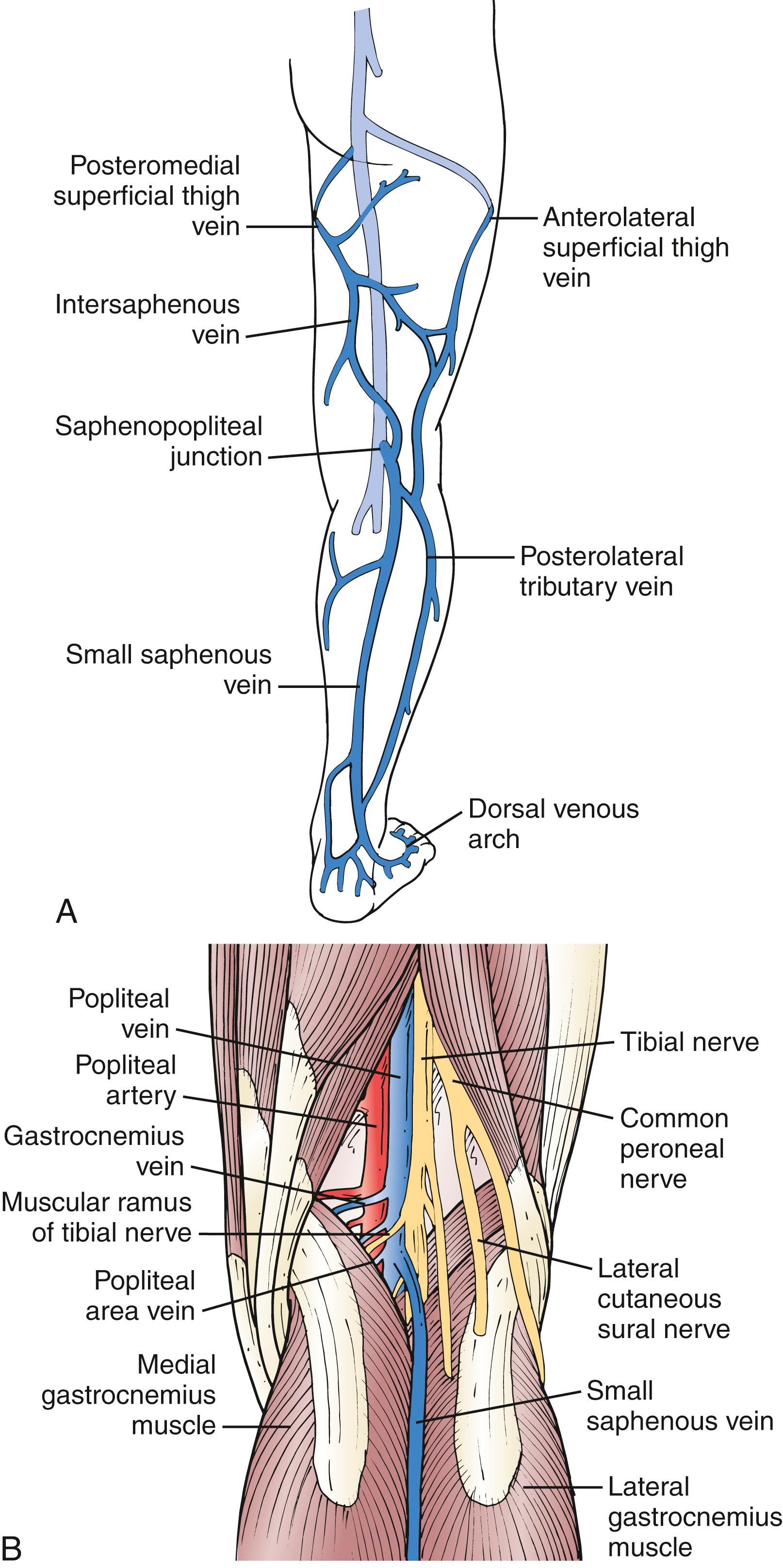Physical Address
304 North Cardinal St.
Dorchester Center, MA 02124
In the past, venous disease received relatively little attention in the public arena and in vascular training programs, despite the fact that it is more prevalent in the United States than coronary artery disease, peripheral arterial disease, congestive heart failure, and stroke combined. The latter half of the 20th century saw dramatic advances in diagnostic testing; however, surgical treatment of varicose veins benefited from only modest refinements. The 21st century launched a resurgence of interest and innovation in venous disease. Increased awareness of thrombotic and venous reflux disease has been coupled with advances in the diagnosis and treatment of acute deep venous thrombosis (DVT) (see Chapter 146, Chapter 147, Chapter 148, Chapter 149, Chapter 150, Chapter 151, Chapter 152 ), and endovenous ablation (EVA) techniques for the treatment of chronic venous disease have proved appealing to patients and physicians alike (see Ch. 155 , Varicose Veins: Endovenous Ablation and Sclerotherapy). Although sclerotherapy and EVA occupy preeminent roles in the contemporary management of superficial venous disease, surgical approaches remain relevant when applied appropriately. In addition to treatment of the great saphenous vein (GSV) and tributary varicosities, this chapter emphasizes management of the small saphenous vein (SSV) and other veins of the popliteal fossa; these veins are important contributors to chronic venous insufficiency (CVI), and they are particularly well suited for treatment with open surgical techniques. In a guidelines publication, Gloviczki et al . recommended specific diagnostic and treatment steps for varicose veins, with the strength of recommendation and quality of supporting evidence. Recommendations specific to the open treatment of axial reflux and tributaries are reported in Table 154.1 .
| Number | Guideline | Strength of Recommendation | Quality of Evidence |
|---|---|---|---|
| 9.1 | We suggest compression therapy using moderate pressure (20–30 mm Hg) for patients with symptomatic varicose veins. | 2 | C |
| 9.2 | We recommend against compression therapy as the primary treatment of symptomatic varicose veins in patients who are candidates for saphenous vein ablation. | 1 | B |
| 9.3 | We recommend compression as the primary therapeutic modality for healing venous ulcers. | 1 | B |
| 11.2 | Because of reduced convalescence and less pain and morbidity, we recommend endovenous thermal ablation of the incompetent saphenous vein over open surgery. | 1 | B |
| 10.1 | For treatment of the incompetent great saphenous vein, we suggest high ligation and inversion stripping of the saphenous vein to the level of the knee. | 2 | B |
| 10.3 | For treatment of small saphenous incompetence, we recommend high ligation of the vein at the knee crease, about 3 to 5 cm distal to the saphenopopliteal junction, with selective invagination of the incompetent portion of the vein. | 1 | B |
| 10.7 | We recommend ambulatory phlebectomy for treatment of varicose veins performed with saphenous vein ablation, either during the same procedure or at a later stage. If general anesthesia is required for phlebectomy, we suggest concomitant saphenous ablation. | 1 | B |
| 10.5 | We suggest that preservation of the saphenous vein using the ambulatory conservative hemodynamic treatment of varicose veins (CHIVA) technique be used only selectively in patients with varicose veins and only when performed by trained venous interventionists. | 2 | B |
| 10.6 | We suggest that preservation of the saphenous vein using the ASVAL under local anesthesia procedure be used only selectively in patients with varicose veins. | 2 | C |
Varicose veins are defined as “subcutaneous veins in the lower extremities which are dilated to ≥3 mm in diameter in the upright position”. They can occur in the axial superficial veins (GSV and SSV) and/or in any of their tributaries. Current thinking is that they represent primary venous disease and occur as a result of structural weakening of the vein wall, which can be focal or diffuse. This weakening is most likely the result of underlying morphologic or biochemical abnormalities. Valvular incompetence in the superficial veins is usually present, which may represent an inciting factor or a secondary result of vein wall dilation. Varicose veins can also occur as a result of secondary venous disease (post-thrombotic). ,
Varicose veins constitute a progressive disease; remission does not occur except after pregnancy. Venous disease produces symptoms which frequently prompt the patient to seek medical care. Symptoms and signs include lower extremity pain and swelling, particularly after prolonged standing, and a feeling of heaviness in the lower extremities. The most frequent complications are superficial thrombophlebitis, bleeding from thin-walled varices, eczema, and skin ulceration. Depending on his or her age, general health condition, and symptomatology, a patient with varicose veins may be offered one or more of the following: no treatment, conservative management with compression, venotonic medications, sclerotherapy, or surgical treatment (open or endovascular). CVI is common in western societies and affects approximately one-third of the adult population. Fortunately, only a small proportion of these patients develop the most severe form of venous insufficiency – namely venous ulcers. Though affecting only a small fraction of the population with venous insufficiency, venous ulcers are reported to occur in up to 4% of people older than 65 years. , Even though nonoperative management of venous disease – including compression, elevation, and skin care – is beneficial, such therapy does not correct the underlying pathology, allows recurrence of symptoms if patients are unable to comply with the elevation and compression regimen, and is associated with a high incidence of recurrent ulceration.
Invasive treatment of superficial venous incompetence can be accomplished by techniques that remove, ablate, or ligate the refluxing venous segment. Current options for eliminating this target reflux include high ligation, ligation and stripping (L&S), EVA, sclerotherapy, chemical ablation (glue), and ambulatory phlebectomy. Each of these techniques has a role in the treatment of patients with symptomatic varicose veins. Vascular surgeons should be comfortable in applying these procedures in a thoughtful manner based on the patient’s individual needs. As requested by insurers, a trial of compression treatment is generally employed with compression hose (20–30 mm Hg) for patients in CEAP classification C2 to C4 to determine whether the patient’s symptoms are relieved. For patients with an ulcer (C6), compression therapy with 30–40 mm Hg garments is recommended.
When considering any intervention, the patient’s medical status and venous anatomy should be considered. Because venous insufficiency results in chronic discomfort and stasis changes that may be ameliorated by compression garments, skin care, and lifestyle changes, venous surgery must always be considered somewhat elective; accordingly, prudent consideration of medical factors is indicated. Patients who are fit, with longer life expectancies, have reduced risk for complications from the procedure as well as a longer period during which the benefits may accrue. The advent of less invasive treatment by EVA has expanded the range of ages being treated; indeed, patients over 70 years of age are now routinely treated safely. Patients with severe comorbid conditions are typically managed with conservative measures. In recognition of the shorter recovery time and reduced pain and morbidity, the Varicose Vein Guidelines (VVGL) recommend endovenous thermal ablation over open treatment of saphenous incompetence (see Table 154.1 , VVGL 11.2), for most patients.
The lower extremity venous system is unique in its need to overcome gravity while returning blood toward the heart. The calf muscle pump and vein valve system normally accomplish this task efficiently. The thin vein valves float open in the venous stream during prograde flow. During calf muscle relaxation, retrograde flow and higher supravalvular pressure cause the valve cusps to oppose, so that reflux is prevented. These valves can be disrupted by thrombotic events (secondary), can be congenitally absent or atretic, or can become dysfunctional over time (primary). The anatomic classification of CVI is important because it links the location of CVI with its subsequent clinical management.
The GSV arises anterior to the medial malleolus and courses obliquely and posteriorly as it crosses the anteromedial surface of the calf. At or below the knee joint, the posterior arch vein joins. A solitary vein is found in the calf in two-thirds of cases, whereas a duplicated system is present in the remainder. The GSV at the calf level is usually anterior-dominant. As the main saphenous trunk continues in a slightly more superficial plane around the knee joint, an anterior accessory vein often merges. The GSV then courses cephalad on top of the deep fascia and deep to the superficial fascia ( Fig. 154.1 ). The GSV may run within this envelope for the entire length of the thigh or may enter at some distance above the knee. If the GSV is “duplicated,” both veins run in this fascial envelope; there may be anterior and posterior accessory veins that enter the fascial envelope to join the GSV, but they exist primarily in the extra-fascial plane. Three anatomic variants have been characterized and are demonstrated in Figure 154.2 . Kupinski reported on duplex ultrasound (DUS) evaluation of the GSV in nearly 1500 limbs. At the thigh level in 60% of the limbs the GSV had a single medial-dominant system, whereas a branching double system was observed in nearly 20%, a complete double system in 10%, a closed-loop system in 10%, and a lateral-dominant system in 8%.


The confluence of the SSV with the popliteal vein has long been recognized as variable ( Fig. 154.3 ). Approximately 33% of SSVs terminate at a (high) above-knee popliteal vein site; a low termination site is unusual (<10%). We have observed that DUS examination of the SSV allows exact localization of the saphenopopliteal junction for appropriate placement of the skin incision.

The gastrocnemius veins arise from both the medial and lateral heads of the gastrocnemius muscle and may join the popliteal vein directly or merge with the SSV to form a common trunk before joining the popliteal vein. Hobbs and Vandendriessche reported a 20% incidence of incompetence of the gastrocnemius veins, a proportion similar to that described by Gillet and colleagues in 180 operations for SSV reflux. If the SSV is ligated distal to its junction with a common trunk and an incompetent gastrocnemius vein, persistent reflux will occur.
The second important non-SSV vein of the popliteal fossa, the intersaphenous (formerly named Giacomini) vein, has been classically described as coursing up the posterior medial aspect of the thigh. The intersaphenous vein usually arises off the SSV either as a branch or as a truncal continuation of the SSV, and courses along a subfascial plane to join the GSV more frequently (64%) than the deep venous system (45%). Reflux is less frequent in the intersaphenous vein than in either saphenous vein. The proportion of limbs with intersaphenous vein incompetence, however, is greatly increased when incompetence of the SSV is found alone (odds ratio of 11.94) or combined with GSV incompetence (odds ratio of 11.7), and this vein may facilitate reflux between the GSV and SSV. In our series a dominant and incompetent intersaphenous vein that formed a common trunk with the SSV was observed in 8.5% of limbs undergoing surgery for SSV reflux. Delis’ DUS study of 818 limbs also showed a low 3% incidence of popliteal area veins, the third non-SSV vein of the popliteal fossa. By contrast, Dodd’s classic study of 444 operations in the popliteal fossa showed popliteal area veins in 177 cases (40%), and in 60% they were branches of the SSV (50%) or gastrocnemius veins. They directly entered the popliteal vein in 37% of cases.
Surgical exploration of the popliteal fossa can be associated with postoperative neurologic disability and, rarely, disastrous complications. Two motor nerves, the tibial and occasionally a low-lying sciatic nerve, can be juxtaposed near the SSV and its termination with the popliteal vein. The tendon-like appearance of both motor nerves may falsely encourage the surgeon to perform a less delicate dissection or to retract more vigorously in a deeper plane than would be carried out when a nerve is clearly identified. The sensory sural nerve courses superficial to the SSV or may intertwine with it, and this nerve can also be damaged by retraction or dissection.
Perforating veins connect the superficial venous system to the deep venous system and are discussed in detail in Chapter 158 , Chronic Venous Insufficiency: Treatment of Perforator Vein Incompetence.
Surgery for superficial varicose veins should be individualized according to the patient’s preoperative evaluation. A combination of ligation, axial stripping, and stab phlebectomy may be applied as needed to the GSV, SSV, tributary veins, and perforating veins. Technical considerations for each of these techniques are summarized in the following sections.
After preoperative evaluation elucidates the necessary scope of surgery, a decision is made regarding the appropriate method of anesthesia and site of service. Any of the surgical procedures can be performed under general or regional anesthesia in an operating theater. This level of care may be appropriate for patients undergoing multiple incisions, requiring extended procedure times or those with medical or anxiety issues requiring monitoring by an anesthesiologist. However, tumescent local anesthetic techniques, with or without sedation, allow essentially any of these vein operations to be performed in an office procedure room. Ultimately the decision is influenced primarily by local resources, physician experience, and patient expectations. Preoperative marking of the patient in the standing position is important whenever stab phlebectomy or direct perforator ligation is contemplated. Such marking is essential because visualization of varicose tributaries may be impossible once the patient is prepared and the leg elevated.
Become a Clinical Tree membership for Full access and enjoy Unlimited articles
If you are a member. Log in here